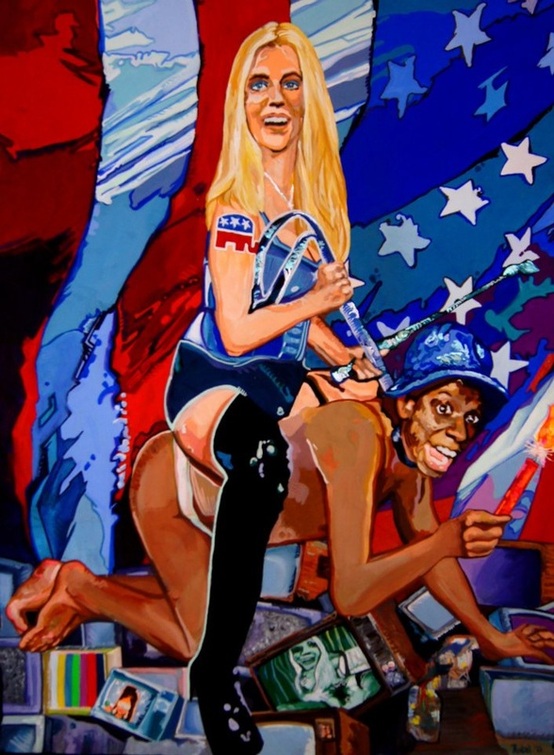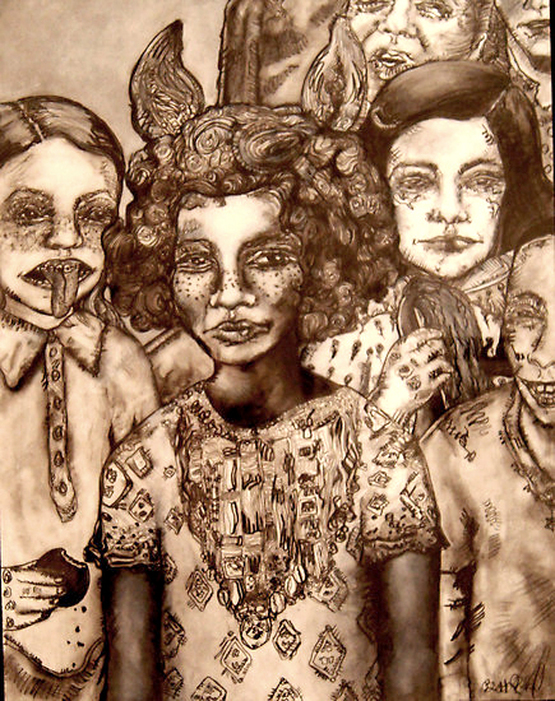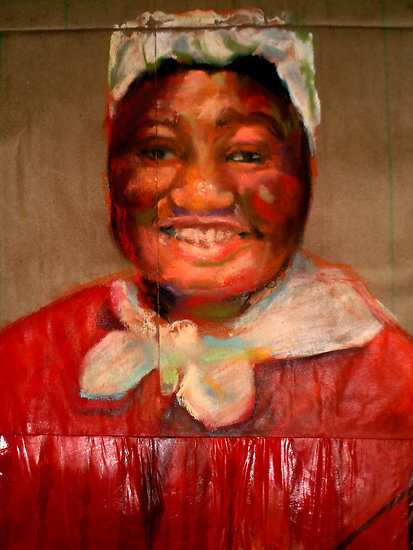An Interview with Visual Artist Beth Consetta Rubel
Consetta Rubel appears as a cheerful shock of purple hair and a wide smile as she enters Genuine Joe Coffee, a cozy café and the place she works part-time as a barista. The rest of her time, she tells me, is spent making art, and in preparation for her exhibit June 13th entitled “Works on Paper” at New East Arts Gallery, Consetta sat down to talk about her thoughts on art, pop culture, and her experience growing up as a biracial woman in Texas.
|
Between a Mulatto and a Quadroon, |
TERRAL: Who are you, and what do you do?
CONSETTA: My name is Beth Consetta Rubel, and I am a visual artist in Austin, Texas. I am a biracial woman and queer, so that’s how I identify.
TERRAL: What media do you work with?
CONSETTA: I prefer to do a lot of drawing mediums; colored pencils, wash, I do a lot of mixed media. I like the immediacy of drawing versus painting, I don’t have the patience for oil paint to dry, and [laughs] I think watercolors are the devil’s paint because there’s no white.
TERRAL: Is there a seminal experience or memory that you go back to often when you’re working?
CONSETTA: I would say the majority of my art is based on personal experiences or those of my family members and friends. Most of my artwork involves the racism I’ve experienced growing up in Texas as a biracial woman or cultural identity, so I usually draw back on my memories of intolerance and what’s in the media.
TERRAL: Do you look at that intolerance in a certain way, as memories that make you angry?
CONSETTA: I get a lot that my art is pretty negative, and it’s because I’m drawing from those experiences. I have some paintings that are a little more graphic. [She pulls this painting from behind a couch and shrugs.]
 Ann Coulter & Jimmie Walker Do Amerikkka, |
I had a lot of customers complain and so I had to take it down. I’m painting what’s really happening, it’s not fiction. They were actually a couple, they did it. People don’t know that so they get offended and are thinking, “Oh you’re racist,” and really I’m just painting what’s happening.
TERRAL: What are your artistic influences?
CONSETTA: I really like Michael Ray Charles, and Carol Walker. Those are my two favorite ones right now.
TERRAL: How do you do your work, do you have a studio?
CONSETTA: My kitchen is my studio. I usually begin with research and then do a few sketches but I don’t really focus on sketches too much. Once I get an idea in my head I try to tackle it as soon as I can.
TERRAL: What’s the dream goal for your art?
CONSETTA: I want my art to focus more on biracial identity and the mixed-race experience, because I get a lot of “you’re not black enough to be painting what you’re painting,” and that’s people assuming. They see my racial identity, my phenotype and my hair texture and whatever they want to assume. I want to do more art that reflects that mixed-race experience, I don’t see it out there enough. But it’s also what I struggle with because I haven’t seen that, what do I reference? It’s starting from scratch, but I want my artwork to be more personal eventually.
 Biggie Smalls, |
TERRAL: I’ve noticed hip-hop playing a large role in some of your pieces.
CONSETTA: Yeah, absolutely. I think the video vixens of hip-hop coincide with a lot of history. When I see the things like that in media and hip-hop videos, I make an instant connection to what’s happened in the past, so that’s plays a huge role. The video vixens remind me of Sarah Bartman, and how she was captured and put on display for the Europeans. I could rant.
TERRAL: In your artist statement, you distinguish pop culture as a driving force.
CONSETTA: I feel that pop culture plays a huge role in how we view race. For me, growing up with a black mother and a white father, that was something that was totally natural to me. When I started dealing with racism, it was super confusing. My art is me trying to understand why racism exists: is it something people watch on tv? Is it something we’re born with, or is a learned behavior? I feel like it’s the latter, and that hip-hop and the media contribute a lot to racist thinking. The whole “Miley Cyrus thing,” tv, or whatever.
TERRAL: In particular with Miley Cyrus, it seems her actions were very deliberate. Prior to her transformation, she went to the record company and asked for something “black”.
CONSETTA: I heard that, and those things happen all the time. Maybe it’s mentioned once that day, but then we forget about it. That’s what drives me crazy about pop culture and media. That she’s getting away with…. whatever.
|
|
TERRAL: Part of your exhibit on June 13th includes portraits on brown paper bags.
CONSETTA: Yeah, it’s called “Works on Paper.” I have some paintings that aren’t a part of the series, but the majority are drawings on brown paper bags and it’s about the ‘Brown Paper Bag Test’, which was a test used by African-American sororities and fraternities in some colleges where an applicant’s photo would be compared with a brown paper bag. If the applicant was darker than the paper bag, they weren’t accepted. The series includes portraits of people that I know along with some celebrities.
TERRAL: A lot of your art is political like that. Do you think it’s important for art to be political and strive to affect the public sphere?
CONSETTA: For me it’s important because that’s how I express myself. I want my art to have a political message; I feel that a lot of art becomes “disposable” because it’s only aesthetically pleasing, and there’s nothing wrong with that but I do feel that art should have a concept and message, especially for me.
You can check Consetta out on her personal website or on Facebook
Terral Wells is a writer and English student at the University of Texas and the editor of Austin East Side Arts Magazine. You can follow him on Twitter if you want.


 “Brown Paper Bag Test II”,
“Brown Paper Bag Test II”,